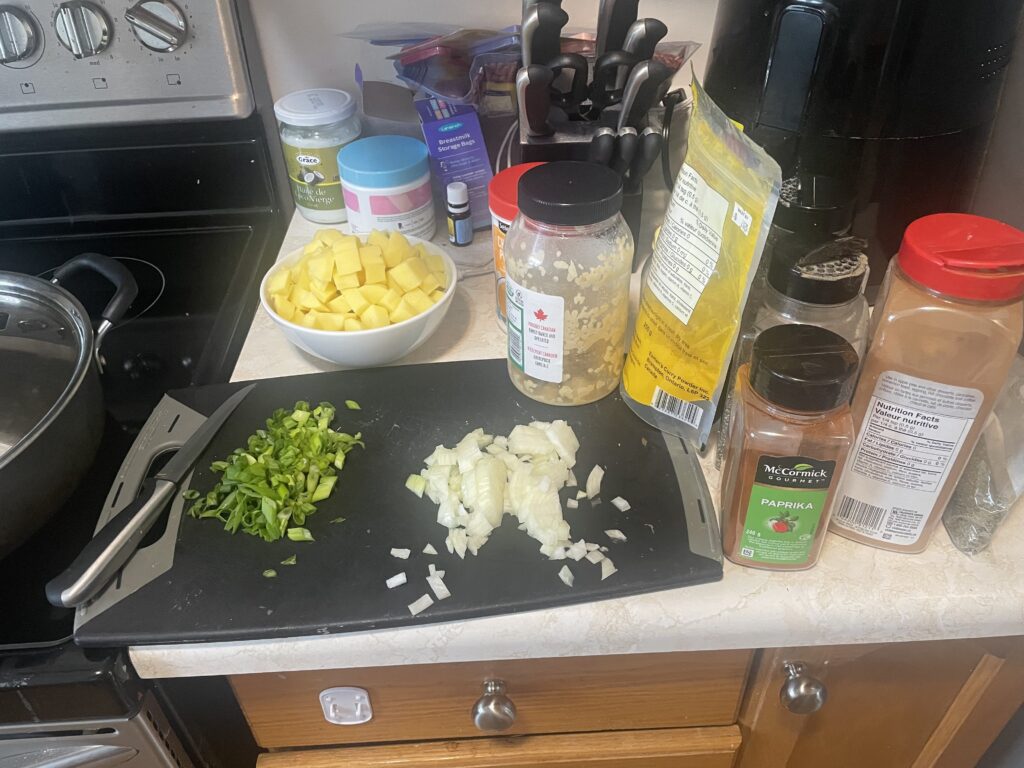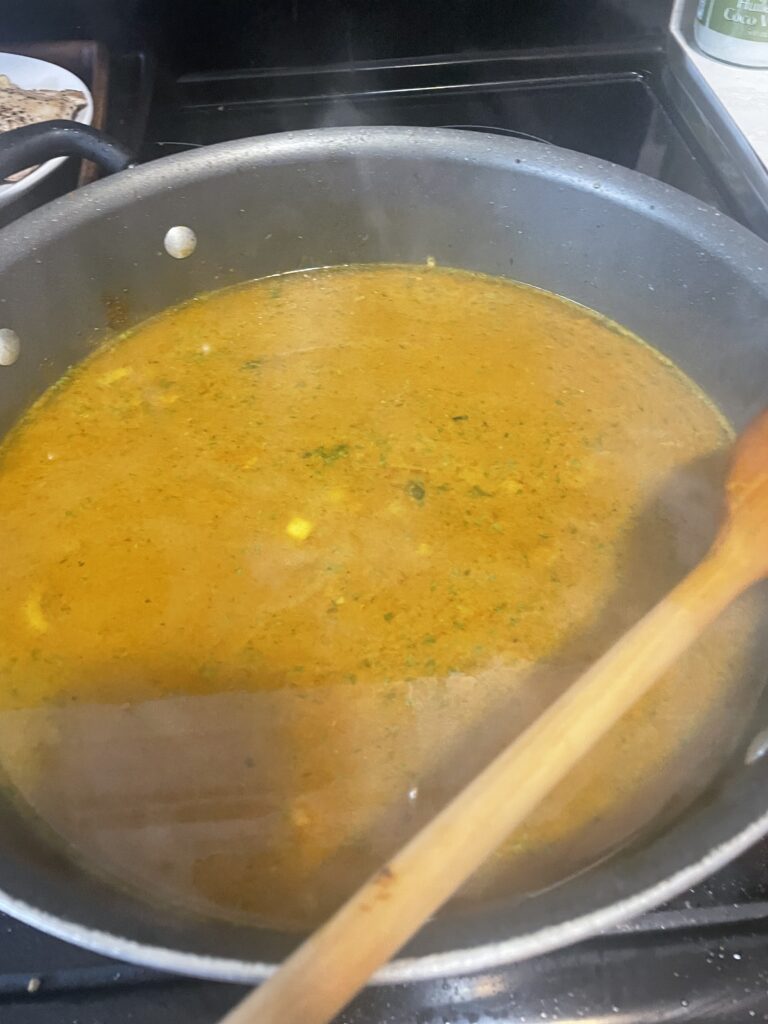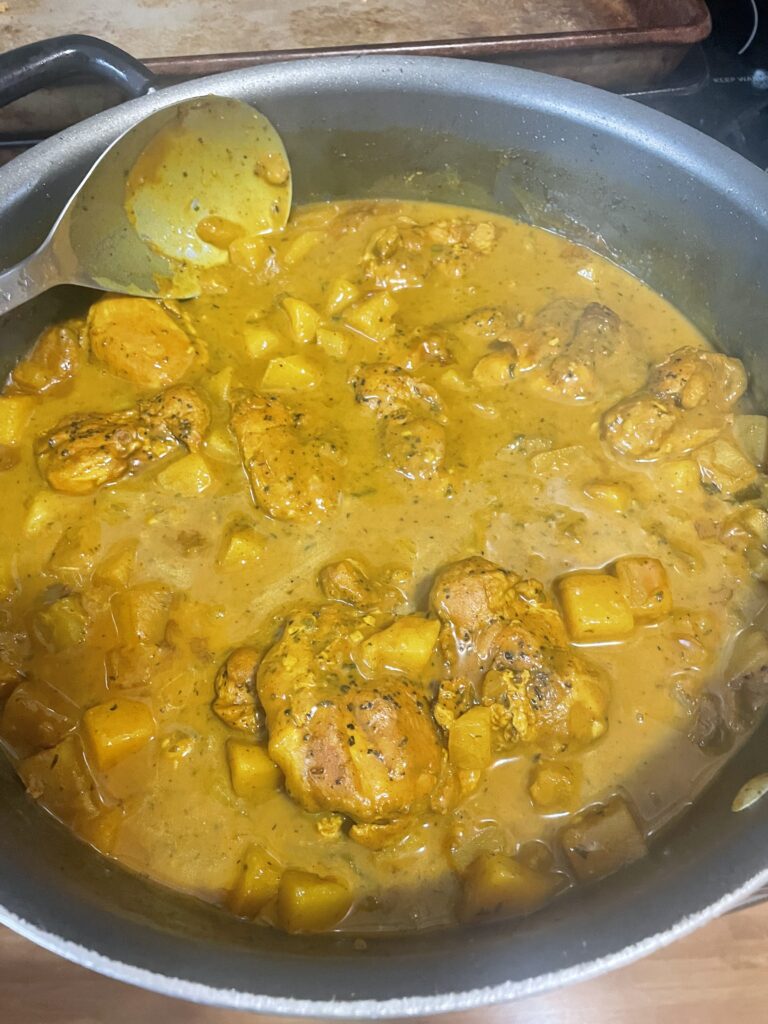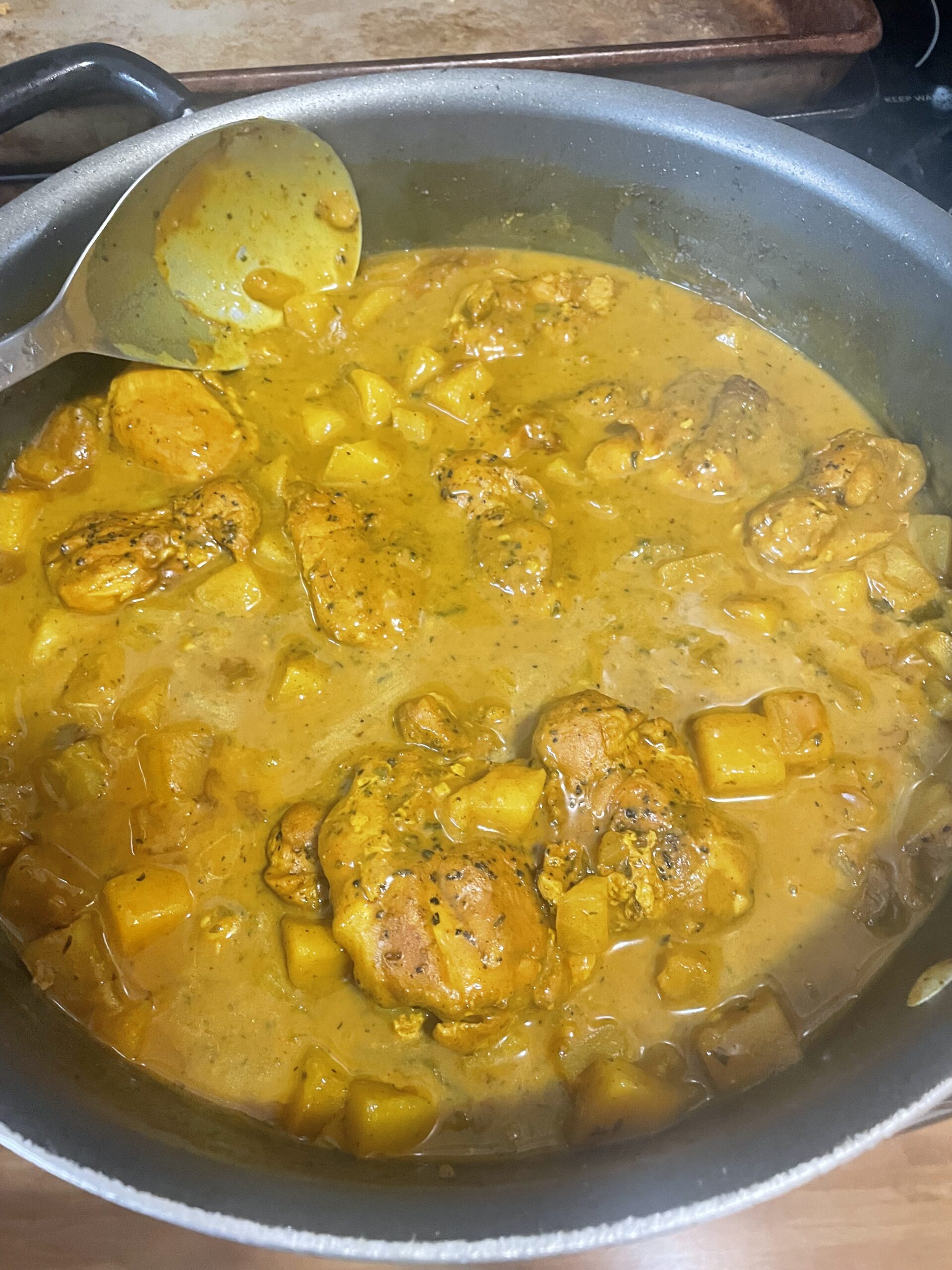This post may contain paid and/or affiliate links. I may make a small commission at no extra cost to you. Please see our Privacy Policy.
Curry chicken is a staple in our house, especially coming from a West Indian family. Growing up I loved coming home and smelling curry when I got home from school because I knew it was going to be a great meal.
So if you are craving a delicious and simple dish that bursts with flavour? Look no further than this easy Guyanese-style chicken curry recipe.
This dish combines tender chicken with a rich blend of spices, creating a meal that’s both satisfying and unforgettable.

Guyanese chicken curry is known for its unique mix of curry powder, garam masala, and fresh herbs, offering a distinct taste that sets it apart from other curries.
With just a bit of prep work, you can bring the vibrant flavours of Guyana right into your kitchen.
Whether you’re new to cooking or a seasoned home chef, you’ll appreciate the straightforward steps in preparing this dish.
Marinate the chicken, make the curry paste, and simmer everything together.
Soon, your kitchen will be filled with the enticing aroma of Guyanese spices, inviting everyone to gather around the table.
Ingredients
Creating a perfect Guyanese-style curry chicken requires selecting the right type of chicken, using an array of bold spices and seasonings, and adding key additional ingredients for flavour and texture.

Chicken Selection
Choosing the right chicken is important for this dish. Many prefer chicken thighs because they are juicy and flavourful. Thighs tend to stay moist during cooking and absorb the spices well.
Chicken breasts can also be used if you prefer leaner meat. They cook faster but can dry out, so it’s essential to monitor cooking times carefully. Make sure to cut the chicken into even pieces to ensure it cooks uniformly.
Spices and Seasonings
The spices and seasonings are the heart of this curry.
Start by marinating the chicken with a good amount of garam masala and Madras curry powder. Be sure to massage these spices into the meat for full flavour penetration.
Green seasoning is another vital component. It typically includes a mix of scallions, cilantro, and parsley blended with a small amount of water until smooth.
For a spicy kick, add wiri wiri peppers. These small, red peppers pack significant heat, so use them according to your preference.
Incorporate whole spices like a small cinnamon stick and cloves if you like more depth.
Additional Ingredients
Other ingredients play a crucial role in this recipe.
Cloves of garlic are often added to the curry paste, made by blending onion, garlic, scallions, cilantro, parsley, and wiri wiri peppers with a half cup of water.
To begin cooking, heat some vegetable oil in a pot. Once heated, add the marinated chicken and cook until seared on all sides. You might also want to include a small cinnamon stick and a few cloves for added flavour.
Allow the chicken to simmer in the curry paste and green seasoning mixture, letting the flavours meld together. Be patient and let it cook on a medium flame, stirring occasionally.

Preparation
Preparing Guyanese-style curry chicken involves key steps such as seasoning the chicken, creating a flavourful curry base, and following some final steps to bring everything together.
Seasoning the Chicken
Begin by washing the chicken and cutting it into even pieces. Dry the pieces with a paper towel.
Season with garam masala, curry powder, and a mix of green seasoning.
Massage the spices into the chicken thoroughly. Then, cover the marinated chicken with plastic wrap or a clean dish towel. Let it marinate for at least 30 minutes. For deeper flavour, refrigerate overnight. This step ensures the spices permeate the meat, resulting in a richly flavoured dish.

Creating the Curry Base
In a food processor, blend onion, garlic, scallions, cilantro, and parsley with a bit of water. This creates a smooth curry paste. Add tomato paste to the mixture, enhancing the richness.
Heat oil in a large pot over medium heat. Sauté the curry paste until fragrant, indicating the release of the spices’ essential oils.
Add additional curry powder and garam masala to the pot, stirring until the spices are well combined and aromatic. This forms the foundation of your curry’s flavour.
Final Steps
To complete the dish, add the seasoned chicken to the pot, ensuring it is well-coated with the curry base.
Cook on medium heat for 15–20 minutes, stirring occasionally to prevent sticking. Cover the pot to allow the chicken to cook evenly.
Remove the lid, letting the liquid reduce until it reaches your desired consistency.
Adjust the seasoning with salt and pepper. For an extra touch, add a small cinnamon stick and cloves while the curry simmers. Serve your completed Guyanese curry chicken hot, paired with rice or roti.
Cooking Process
You need to control the heat carefully and adjust the spices and water to achieve the best chicken curry. Follow these steps closely for a delicious Guyanese-style meal.
Cooking on Medium Heat
Start by heating a large pot over medium heat. Add vegetable oil and wait until it shimmers.
Introduce the chicken pieces, searing them until they achieve a golden brown colour. This process will lock in the flavours and give the chicken a nice crust.
After searing the chicken, add a finely blended spice mixture of onions, garlic, scallions, and hot peppers to the pot.
Stir well to coat the chicken uniformly with the spices. Include whole spices like a small cinnamon stick and cloves.
Cover the pot and let the chicken cook for 15-20 minutes on medium heat, stirring occasionally.
This step is crucial to ensure that the chicken absorbs all the flavours from the spices. Make sure you turn the chicken pieces frequently to avoid sticking and ensure an even cook.
Adjusting Spices and Water
While cooking, you may need to adjust the spices and water to get the perfect consistency and flavour for your curry.
If the curry seems too dry, add small amounts of water gradually. You want enough water to create a rich, flavourful sauce without making the dish too watery.
Taste the curry and decide if it needs more salt, pepper, or other spices.
Guyanese chicken curry often includes a mix of masala, curry powder, and fresh herbs. Feel free to adjust these spices to your preference.
Keep the lid off during the final minutes to let any excess water reduce and thicken the curry.
Remember, the perfect Guyanese chicken curry should have a balance of spices and a thicker sauce that clings to the chicken.
Storage and Serving Suggestions
Proper storage ensures your curry chicken stays fresh, while the right serving techniques enhance its flavours. Focus on keeping leftovers safe and presenting the dish in an appealing way.
Storing Leftovers
To store leftover curry chicken, transfer it to an airtight container. This will help keep it fresh and prevent spills.
Place the container in the fridge within two hours of cooking to maintain food safety. Your curry can remain in the fridge for up to 3-4 days.
For longer storage, portion the curry into smaller containers or freezer bags.
Freeze them, ensuring to label each with the date. Frozen curry chicken can last up to three months.
When ready to use, thaw it in the fridge overnight or use the microwave’s defrost setting.
Reheat thoroughly on the stove or in the microwave until it’s piping hot to avoid any foodborne illnesses.

Serving Recommendations
When serving Guyanese-style curry chicken, consider pairing it with traditional sides like steamed rice, roti, or naan. The mild taste of these sides balances the rich, spicy curry.
Add a cooling touch with a cucumber and tomato salad, dressed lightly with lime juice.
For an elevated presentation, garnish your curry with chopped cilantro and a few slices of fresh chili pepper. This not only adds colour but also an extra layer of flavour.
If you prefer, you can also serve it with a side of mango chutney for a sweet contrast.
Keep extra curry warm in a slow cooker or covered dish on low heat if serving buffet-style. This ensures guests can enjoy it hot without drying out the chicken.

Guyanese Chicken and Broccoli Curry Recipe
Ingredients
Method
- Dice the onion, cut the broccoli into small florets, and cube the chicken (cut the chicken last to avoid cross-contamination).
- In a medium pot, boil 2 cups of water, add the rice, reduce heat to low, and simmer for 15 minutes. Remove from heat and keep covered.
- Heat a large pan over medium-high heat, add oil, and cook the chicken until browned. Remove from the pan and set aside.
- In the same pan, sauté the onion with curry powder, paprika, cinnamon, and thyme until fragrant.
- Add the chicken stock and bring to a boil. Return the chicken to the pan along with the potatoes and broccoli. Simmer until the potatoes and broccoli are tender.
- Stir in the cooking cream, season with salt and pepper, and cook for 2 more minutes.
- Serve hot over rice and enjoy!

